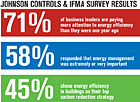
The Energy Efficiency Indicator (EEI) survey respondents - majority of which were CEOs, vice presidents, general managers, or facility directors - are primarily responsible for managing, reviewing, or monitoring energy use within their organizations.
Their responses revealed that approximately 71 percent of business leaders are paying more attention to energy efficiency than they were one year ago. Fifty-eight percent responded that energy management was extremely or very important. Of the organizations making public carbon commitments, 45 percent identified energy efficiency in buildings as their top carbon reduction strategy.
Sustainability continued as a focus for new construction projects as 38 percent are seeking green building certification, while 45 percent plan to incorporate green elements, but not certify their facilities.
“This research recognizes the important role workplace professionals play in controlling operational costs related to energy consumption and making strategic capital investments in high-performing building technologies,” said Don Young, vice president of communications, IFMA. “Indications are that as the economy recovers, we will see greater investments in energy reduction and sustainable initiatives.”
LIMITED CAPITAL IMPEDES INVESTMENTS
The EEI survey also revealed barriers to investing in energy efficiency including limited funding, uncertainty about future energy prices, government incentives, and energy and climate legislation.“These findings highlight the fact that business leaders across the U.S. are increasingly aware of the need for energy efficiency and its potential to reduce operating costs while cutting greenhouse gas emissions,” said C. David Myers, president of Johnson Controls building efficiency division. “Economic and regulatory uncertainty, however, are inhibiting organizations from investing in proactive measures.”
According to the EEI, there is a 10 percent decrease from last year in the use of facility capital budgets to fund energy-efficiency projects. It also revealed a 6 percent decrease in the number of respondents planning to make investments using their operational budgets.
When asked about the barriers to capture potential energy savings, 42 percent of respondents cited limited capital availability for investments and 21 percent cited unattractive payback. Nearly 50 percent of executives who oversee energy-efficiency investments expect a payback period that is less than three years.
INVESTMENT DRIVERS
The EEI research indicates that business leaders believe incentives from utilities or government will drive investment. Eighty-five percent stated that legislation mandating energy efficiency and/or carbon reduction is likely within the next two years. This data supports a continual upward trend, increasing from 76 percent in 2008. Forty-four percent report that incentives are very/extremely important as they make decisions on energy efficiency, up from 38 percent in 2008.There doesn’t seem to be a consensus among respondents, however, about whether energy prices will decrease or increase.
“We see a wide distribution of views about what will happen to energy prices - ranging from a 100 percent increase to a 60 percent decrease,” said Clay Nesler, vice president of global energy and sustainability at Johnson Controls.
“This uncertainty appears to be another reason business leaders are holding back on investments.”
RENEWABLES PERSPECTIVE
Survey participants also were asked about on-site renewable energy technologies.Leaders stated they were considering a range of technologies, including wind, solar thermal, solar electric, and geothermal sources of energy.
Forty-six percent reported considering solar electric - an increase of 8 percent over the previous year. Geothermal energy also received a substantial increase in interest level, up by 7 percent.
For more information, visit www.johnsoncontrols.com.
Publication date:06/01/2009

Report Abusive Comment